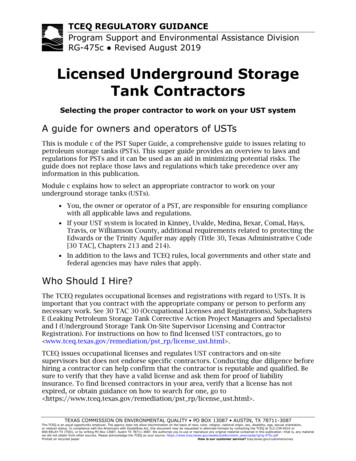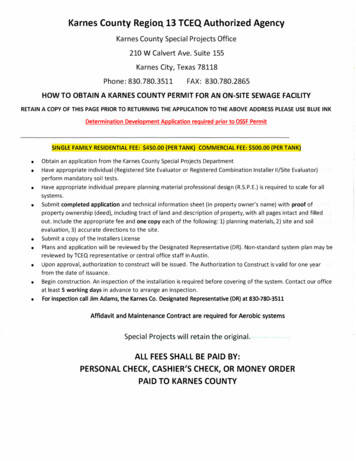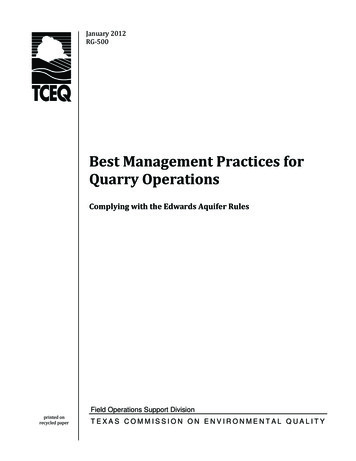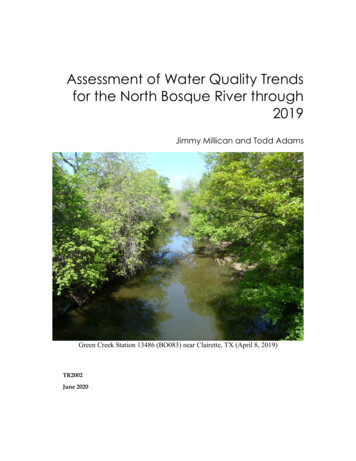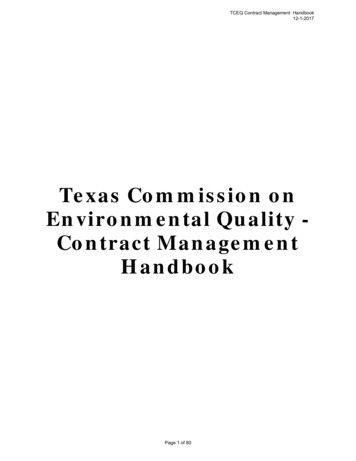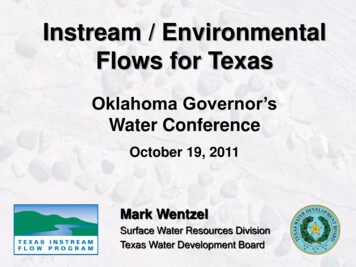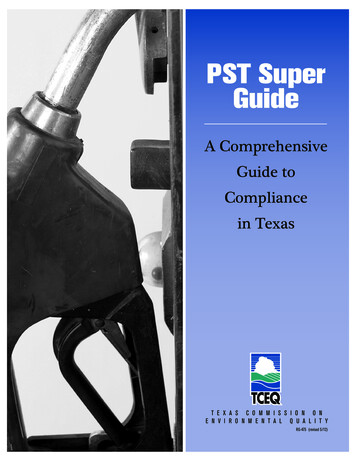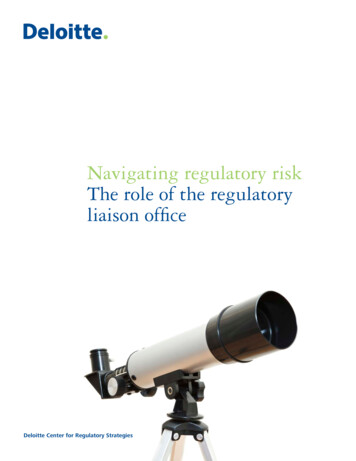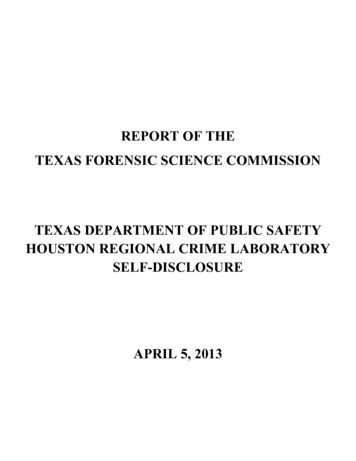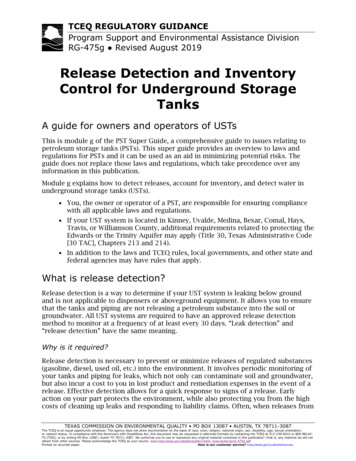
Transcription
TCEQ REGULATORY GUIDANCEProgram Support and Environmental Assistance DivisionRG-475g Revised August 2019Release Detection and InventoryControl for Underground StorageTanksA guide for owners and operators of USTsThis is module g of the PST Super Guide, a comprehensive guide to issues relating topetroleum storage tanks (PSTs). This super guide provides an overview to laws andregulations for PSTs and it can be used as an aid in minimizing potential risks. Theguide does not replace those laws and regulations, which take precedence over anyinformation in this publication.Module g explains how to detect releases, account for inventory, and detect water inunderground storage tanks (USTs). You, the owner or operator of a PST, are responsible for ensuring compliancewith all applicable laws and regulations. If your UST system is located in Kinney, Uvalde, Medina, Bexar, Comal, Hays,Travis, or Williamson County, additional requirements related to protecting theEdwards or the Trinity Aquifer may apply (Title 30, Texas Administrative Code[30 TAC], Chapters 213 and 214). In addition to the laws and TCEQ rules, local governments, and other state andfederal agencies may have rules that apply.What is release detection?Release detection is a way to determine if your UST system is leaking below groundand is not applicable to dispensers or aboveground equipment. It allows you to ensurethat the tanks and piping are not releasing a petroleum substance into the soil orgroundwater. All UST systems are required to have an approved release detectionmethod to monitor at a frequency of at least every 30 days. “Leak detection” and“release detection” have the same meaning.Why is it required?Release detection is necessary to prevent or minimize releases of regulated substances(gasoline, diesel, used oil, etc.) into the environment. It involves periodic monitoring ofyour tanks and piping for leaks, which not only can contaminate soil and groundwater,but also incur a cost to you in lost product and remediation expenses in the event of arelease. Effective detection allows for a quick response to signs of a release. Earlyaction on your part protects the environment, while also protecting you from the highcosts of cleaning up leaks and responding to liability claims. Often, when releases fromTEXAS COMMISSION ON ENVIRONMENTAL QUALITY PO BOX 13087 AUSTIN, TX 78711-3087The TCEQ is an equal opportunity employer. The agency does not allow discrimination on the basis of race, color, religion, national origin, sex, disability, age, sexual orientation,or veteran status. In compliance with the Americans with Disabilities Act, this document may be requested in alternate formats by contacting the TCEQ at 512-239-0010 or 800-RELAYTX (TDD), or by writing PO Box 13087, Austin TX 78711-3087. We authorize you to use or reproduce any original material contained in this publication—that is, any material we did notobtain from other sources. Please acknowledge the TCEQ as your source. www.tceq.texas.gov/assets/public/comm exec/pubs/rg/rg-475g.pdfPrinted on recycled paper.How is our customer service? tceq.texas.gov/customersurvey
Release Detection and Inventory Control for Underground Storage TanksTCEQ publication RG-475gUST systems occur, the petroleum substance can affect soil or groundwater over anarea much larger than the property on which the tanks are located, affecting otherparties, and increasing the cost of cleanup.Remember that release detection applies to both tanks and product piping. Together,the tanks and piping are referred to as a “UST system.” TCEQ rules apply to the USTsystem from underground up to the point where piping exits the ground, leading tothe dispenser. Leak detection only affects that part of the UST system that is installedbelow ground, not dispensers or aboveground equipment.Many methods are available for monitoring your tanks and piping for leaks, and theymay be used in multiple combinations to achieve compliance. Some methods covertanks only, some cover piping only, and some cover both tank and piping. It isimportant that you look at release detection not just as something required, but alsoas a tool that will help you make sure a regulated substance is not leaking from yourUST system.What is inventory control?Regardless of your chosen release detection method, all retail facilities (where fuelproducts are sold to the public) are required to perform inventory control. Inventorycontrol is an ongoing accounting system similar to balancing a checkbook. It compareswhat is in the tank to what should be in the tank by reconciling the inputs and outputsof product with the volume remaining in the UST.Each day the tank is used, record the following information in your inventory controlledger or worksheet: records of product deliveries amounts dispensed measured volume of product remaining in the tank (inventory)Electronic Inventory Control Worksheets for blended and non-blended systems areavailable at www.tceq.texas.gov/assistance/industry/pst or you can use your ownpaper ledger.Determine fuel inventory by measuring the product level in the tank in one of twoways:1. Use a measuring stick (sticking the tank) and then convert that level into avolume using a calibration chart specific to the tank size.2. Use an automatic tank gauge capable of measuring the fuel level.At the end of each 30-day monitoring period, compare the book inventory (what yourrecordkeeping indicates you should have based on amount of product dispensed)against the measured inventory to determine the total overage or shortage of product.Next, compare the overage or shortage to the “leak check” value calculated by amathematical formula in the worksheet. The leak check value is described as the sumof 1 percent of the total substance flow-through for the month plus 130 gallons. Tocalculate the “leak check value” on your own ledger, multiply the total gallons ofproduct dispensed by 0.01, then add 130 to that number. Write that answer as the“leak check” value on your ledger. If the overage or shortage exceeds the “leak check”value for two consecutive 30-day periods for the same tank, you must report asuspected release. (See Suspected and Confirmed Releases from Petroleum Storage2August 2019
TCEQ publication RG-475gRelease Detection and Inventory Control for Underground Storage TanksTanks, TCEQ publication RG‐475h, for more information about reporting suspectedreleases.)Check all tanks for water at least once every 30 days. This required 30-day water checkis used to quantify the water in the tank. A small amount may be expected, but it iscritical to remove water from the tank before it interferes with dispensing operations.In addition, a sudden influx of water into the tank should be reported to the TCEQ as asuspected release.If your system has tanks that share a common inventory of fuel, those tanks areconsidered to be “manifolded.” For example, two 1,000-gallon tanks that are connected(via a siphon line) are considered manifolded tanks. For the purpose of inventorycontrol, you should consider all manifolded tanks as a single system.Blended-fuel systems are those with no separate tank for a midgrade product. Forexample, a station sells three grades of gasoline, but only has two tanks. Fuel fromeach tank is blended to create the midgrade fuel. To complete proper inventorycontrol, the blended fuel product must be accounted for in both of the tanks’inventory-control records. Doing proper inventory control on manifolded tanks andblended-fuel systems can be very complicated. For assistance, please call the SBLGAhotline at 800-447-2827.For more details and sample inventory control forms, see the U.S. EnvironmentalProtection Agency’s publication no. 510‐B‐93‐004, Doing Inventory Control Rightavailable at rground-storagetanks .Is inventory control an acceptable method of 30-day release detection?Inventory control is only effective for finding larger leaks and is not considered astand‐alone method of release detection; it must be used in combination with a 30-daymethod that can detect small leaks.What are my options for detecting releases from tanks?Monitor each tank for leaks at least once every 30 days. When properly employed, thefollowing are acceptable methods of 30-day release detection: Automatic tank gauging (ATG) and inventory control use monitorspermanently installed in the tank and linked electronically to a nearby controldevice to report product level and temperature. Often called the “tankmonitor,” the control device is usually mounted on a wall inside a building andhas a keypad with a message screen and a printing device. During a testperiod, the gauging system automatically calculates the changes in productvolume that can indicate a leaking tank. The test will often fail or give aninconclusive result if the product level in the tank is too low or if product isadded to or removed from the tank while the test is being run. Test periodsrequire several hours of quiet time, when nothing is put into or taken from thetank. Users of the ATG system must perform a complete test on each tank atleast once every 30 days and keep all leak test results. A failing test result mayrequire that you notify the TCEQ of a suspected release. For more informationon reporting suspected releases, refer to the module Suspected Releases fromPetroleum Storage Tanks (RG‐475h).August 20193
Release Detection and Inventory Control for Underground Storage TanksTCEQ publication RG-475gIn addition to the ATG leak test, inventory control for each tank must bemaintained as outlined in the previous section. Some ATG systems canperform inventory control and store the results in memory or print a copy. Statistical inventory reconciliation (SIR) and inventory control uses acomputer program to determine whether a tank system is leaking byconducting a statistical analysis of inventory, delivery, and dispensing datacollected over time. You send the data to an SIR vendor, who performs ananalysis to determine if there is a loss trend in the UST system.By the 15th calendar day following the last day of the 30-day monitoringperiod, the SIR vendor supplies a report that indicates whether the UST systemis passing or failing.If the analysis indicates a failure (or an inconclusive result that cannot beimmediately corrected), the situation is considered a suspected release andmust be reported to the TCEQ within 24 hours from the time the operatorreceives the results. Important: even a single SIR failure requires notificationand investigation of a suspected release, even if inventory control indicatesthere is no leak in the tanks. In Texas, SIR is considered a 30-day monitoringmethod of release detection that covers tanks and lines. Interstitial monitoring is used in double‐walled UST systems. Monitoringsensor equipment is designed to detect if product vapors or liquid is presentin the interstitial space between the inner (primary) and outer (secondary)walls of the system. The sensor must monitor the interstitial space betweenthe walls, and the sensor status must be documented at least once every 30days. Document the status by printing your liquid sensor report from themanufacturer, if available, or by manually logging the status by hand. Groundwater monitoring uses monitoring wells that are installed at strategiclocations in the ground near the tank system. Groundwater is monitored forthe presence of liquid product (gasoline, diesel, used oil) floating on itssurface. To discover if leaked product has reached groundwater, these wellsare checked periodically (at least once every 30-days) by hand, or continuouslywith permanently installed equipment (electronic sensors). This method is onlyvalid at sites where groundwater is within 20 feet of the surface year-roundand the subsurface soil or backfill material (or both) consists of gravels, coarseto medium sands, or other similarly permeable materials. The person whoinstalls the wells should state in writing that a release from any part of theUST system will be detected within 30-days of its occurrence. Vapor monitoring is the sensing and measurement of product vapor in thesoil around the tank system to determine whether a leak is present. Thismethod requires installation of carefully placed monitoring wells in the groundnear the tank system. Vapor monitoring can be periodic (at least once every 30days) using manual devices or continuous using permanently installedequipment (electronic sensors). All subsurface soils and backfill material mustbe sufficiently porous (e.g., gravel, sand) to allow vapors to diffuse rapidlythrough the subsurface. For this method of release detection to be acceptable,any preexisting background contamination in the subsurface soils must notinterfere with the ability of the vapor‐monitoring equipment to detect a newrelease. The person who installs the wells should state in writing that a release4August 2019
TCEQ publication RG-475gRelease Detection and Inventory Control for Underground Storage Tanksfrom any part of the UST system will be detected within 30 days of itsoccurrence.Note: For both groundwater monitoring and vapor monitoring, you arerequired to ensure subsurface conditions that enable the monitoring systemsto detect a release from any portion of the system that contains product. Secondary containment barriers are impermeable barriers (i.e., liners, vaults)placed between the UST system and the environment. Leaked product from theUST system is directed toward monitoring points, such as observation wellslocated between the tank system and the secondary containment barrier. Todetermine if a leak has occurred, the wells should be checked periodically (atleast once every 30 days) by hand or continuously with permanently installedequipment (electronic sensors). Manual tank gauging is only acceptable for tanks with a capacity of 1,000gallons or less. It requires a quiet period each week where nothing is added toor removed from the tank. The length of the quiet period depends on thediameter of the tank. For that reason, very few owners or operators use thismethod of release detection. If you would like more information about thismethod, contact the SBLGA hotline at 800-447-2827. 30-day tank gauging is only acceptable for emergency‐generator tanks. Itrequires a quiet period, during which nothing is added to or removed from thetank. The product level is measured at the beginning and end of the quietperiod. The difference between measurements should be within certainstandards based on the capacity of your tank. At the end of module g, there isa 30-day tank gauging tracking sheet. If you would like more information onthis method, contact the SBLGA hotline at 800-447-2827.What other inspections are required?Every 30 days, you must conduct and document a walkthrough inspection to ensureyour release detection equipment is functioning correctly with no unusual operatingconditions. For example, you must check for: Erratic behavior of product dispensing equipment;Sudden loss of product from the UST system;Unexplained presence of water in the tank; andEnsure release detection records are reviewed and current.You must also annually inspect any hand-held equipment you use to conduct releasedetection on your system. For example, if you use a measuring stick to gauge yourproduct level or use a groundwater bailer to monitor groundwater for releases, youmust verify that the measurements are clear, and that the bailer is functioningproperly. Keep records documenting the dates and results of these inspections.What are my options for detecting releases from productpiping?There are two types of piping: pressurized and suction.August 20195
Release Detection and Inventory Control for Underground Storage TanksTCEQ publication RG-475gPressurized PipingEach pressurized product line (from the USTs to the fuel dispenser) is required to havean automatic line-leak detector (ALLD) designed to detect and prevent a large orcatastrophic leak (of at least 3 gallons per hour) in the line. Mechanical ALLDs arerequired to be performance tested annually. If you have an electronic ALLD (alsoreferred to as an ELLD) that can self‐test and either print out or store the test results,documentation of the self‐test at least once a year satisfies your ALLD-testingrequirements. Contact your UST contractor for more information about ALLD testing.In addition to an ALLD, pressurized piping requires one of the following releasedetection methods: an annual piping‐tightness test, 30-day vapor monitoring, 30-day groundwater monitoring, 30-day interstitial monitoring, 30-day monitoring with a secondary containment barrier, 30-day SIR and inventory control, or 30-day electronic leak monitoring through an ATG system.Suction PipingSuction piping requires no leak detection if it meets all of the following designrequirements: The below‐grade piping operates at less than atmospheric pressure; The below‐grade piping is sloped so that the contents of the pipe drain backinto the tank when suction is released; Only one check valve is included for each suction line and it is located directlybelow, and as close as possible to, the suction pump; and You are able to verify that these requirements have been met, e.g., via plansprovided by the installer, a consultant, or signed documentation by aregistered UST contractor.Suction piping that does not meet the design requirements listed above must use oneof the following approved methods to meet the release‐detection requirements forpiping: a piping-tightness test once every three years, 30-day vapor monitoring, 30-day groundwater monitoring, 30-day interstitial monitoring, 30-day monitoring with a secondary containment barrier, or 30-day SIR and inventory control.6August 2019
TCEQ publication RG-475gRelease Detection and Inventory Control for Underground Storage TanksWhat release detection records do I need tokeep?All testing and monitoring results, including the results of any annual function test ofmechanical ALLDs, must be kept for at least five years.All equipment used for release detection must have a third‐party certification, whichverifies that the equipment meets EPA standards. Each certification must list theconditions of use and limitations of the equipment. You must maintain copies of thesecertifications while the equipment is in use. You must ensure that the equipment isoperated in accordance with the third‐party certification. Installation and maintenancerecords for the UST system must be maintained for the life of the system and should notbe discarded after five years.The following supplemental record‐keeping forms are included at the end of module g: 30-day Record of Vapor-Well Monitoring 30-day Record of Groundwater-Well Monitoring 30-day Record of Interstitial-Sensor Monitoring 30-day Record of Secondary Containment Well Monitoring Weekly Record of Manual Tank Gauging (Tanks 1,000 gallons) Record of 30-day Tank GaugingWhat if there is a release?If any of the release detection methods discussed in module g indicate that a leak hasoccurred, you are required to report it to TCEQ within 24 hours as a suspected releaseat 512‐239‐2200 or 800‐832‐8224.For more information on what to do in the case of suspected releases, refer to themodule Suspected Releases from Petroleum Storage Tanks (RG‐475h).Where do I find more information?The complete requirements for release detection may be found at 30 TAC 334.50,available online at texreg.sos.state.tx.us/public/readtac ext.TacPage?sl R&app 9&p dir &p rloc &ptloc &p ploc &pg 1&p tac &ti 30&pt 1&ch 334&rl 50 .Resources for PST facilities are available on our website at /pst-datasets-records.html .Requirements for UST systems in the Edwards Aquifer are in 30 TAC 213 availableonline at texreg.sos.state.tx.us/public/readtac ext.ViewTAC?tac view 4&ti 30&pt 1&ch 213 .Requirements for UST systems over other aquifers are in 30 TAC 214 available at texreg.sos.state.tx.us/public/readtac ext.ViewTAC?tac view 4&ti 30&pt 1&ch 214&rl Y .August 20197
Release Detection and Inventory Control for Underground Storage TanksTCEQ publication RG-475gThe Small Business and Local Government Assistance Program has informationdesigned to assist UST system owners and operators online at www.tceq.texas.gov/assistance/industry/pst/ .Download TCEQ publications online at www.tceq.texas.gov/goto/publications .EPA’s Underground Storage Tanks (USTs) webpage (please note that EPA requirementsmay be used as a guideline but differ from Texas requirements) at www.epa.gov/ust .EPA’s Doing Inventory Control Right (publication no. 510‐B‐93‐004) provides detailsand sample inventory control forms at ground-storage-tanks .Suspected Releases from Petroleum Storage Tanks (TCEQ Publication RG‐475h),available online at www.tceq.texas.gov/goto/rg-475 .For confidential environmental compliance assistance for small businesses and localgovernments, contact Small Business and Local Government Assistance via itshotline at 800‐447‐2827 or online at www.TexasEnviroHelp.org .8August 2019
TCEQ publication RG-475gRelease Detection and Inventory Control for Underground Storage Tanks30-Day Record of Vapor-Well MonitoringIf you have questions on how to complete this form or about thePetroleum Storage Tank (PST) program, please contact the SmallBusiness and Local Government Assistance hotline at 1-800-4472827, or online at www.TexasEnviroHelp.org .Facility InformationFacility Name:Facility ID No.:Street Address:City, State, Zip:Instructions Vapor wells must be monitored at least once every 30 days for potential product releases. Monitoring and observation wells must be properly secured to prevent any unauthorized substances being deposited in the well. If there is a suspected release, notify the TCEQ within 24 hours and refer to Suspected and Confirmed Releases from PetroleumStorage Tanks (TCEQ publication RG-475h). Keep this form on file for at least 5 years.Vapor Reading Instrument & Tank InformationInstrument Name and Type:Date Last Calibrated:Depth from Ground Surface to Tank Bottom (in feet):Vapor Monitoring Well RecordDateInspectedAugust 2019Vapor Reading (in PPM)Well #1Well #2Well #3Well #4Well #5Well #6FreeProduct inWell (Y/N)InspectorInitialsComments9
Release Detection and Inventory Control for Underground Storage TanksTCEQ publication RG-475g30-Day Record of GroundwaterWell MonitoringIf you have questions on how to complete this form orabout the Petroleum Storage Tank (PST) program,please contact the Small Business and LocalGovernment Assistance hotline at 1-800-447-2827, oronline at. www.TexasEnviroHelp.org .Facility InformationFacility Name:Street Address:Facility ID No.:City, State, Zip:Instructions Groundwater wells must be monitored at least once every 30 days for potential product releases. Monitoring wells must be properly secured to prevent any unauthorized substances being deposited in the well. Automatic monitoring devices must be capable of detecting at least 1/8 inch of free product on top of the groundwater. Manual monitoring methods must be capable of detecting a visible sheen or other accumulation of regulated substances. If there is a suspected release, notify the TCEQ within 24 hours and refer to Suspected Releases from Petroleum Storage Tanks(TCEQ publication RG-475h). Keep this form on file for at least five years.GroundwaterDepth from Ground Surface (in feet):Depth to Tank Bottom (in feet):Groundwater- Monitoring WellDateInspected10Depth to Top of the Groundwater (in feet)Well #1Well #2Well #3Well #4Well #5Well #6August 2019FreeProduct inWell (Y/N)InspectorInitialsComments
TCEQ publication RG-475gRelease Detection and Inventory Control for Underground Storage Tanks30-Day Record of InterstitialSensor MonitoringFacility InformationFacility Name:Facility ID No.:Street Address:City, State, Zip:If you have questions on how to complete this form orabout the Petroleum Storage Tank (PST) program,please contact the Small Business and LocalGovernment Assistance hotline at 1-800-447-2827, oronline at www.TexasEnviroHelp.org .Instructions Interstitial sensors must be monitored at least once every 30 days for potential product releases. If there is a suspected release, notify the TCEQ within 24 hours and refer to Suspected and Confirmed Releases from PetroleumStorage Tanks (TCEQ publication RG-475h). Keep this form on file for at least five years.Sensor Location (tank or dispenser [T/D])Sensor #1Sensor #2Sensor #3Sensor #4Sensor #5Sensor #6Sensor #5Sensor #6Sensor #7Sensor #8InspectorInitialsCommentsSensor -Status RecordSensor StatusDateInspectedAugust #6Sensor#7Sensor#811
Release Detection and Inventory Control for Underground Storage TanksTCEQ publication RG-475g30-Day Record of SecondaryContainment Well MonitoringIf you have questions on how to complete this form orabout the Petroleum Storage Tank (PST) program, pleasecontact the Small Business and Local GovernmentAssistance hotline at 1-800-447-2827, or online at www.TexasEnviroHelp.org .Facility InformationFacility Name:Facility ID No.:Street Address:City, State, Zip:Instructions Observation wells must be monitored at least once every 30 days for potential product releases. Note: if your system uses observation wells or electronic sensors to determine if there is free product in the secondary containment,record any free product detected. Observation wells must be properly secured to prevent any unauthorized substances being deposited in the well. If there is a suspected release, notify the TCEQ within 24 hours and refer to Suspected and Confirmed Releases from PetroleumStorage Tanks (TCEQ publication RG-475h). Keep this form on file for at least five years.Monitoring MethodSecondary-Containment Release-Detection Method (circle one):Observation WellsElectronic SensorsObservation Well or Sensor-Status RecordDateInspected12Sensor-Status or Well Observation (Free product detected? /Well#4Sensor/Well#5Sensor/Well#6August 2019InspectorInitialsComments
TCEQ publication RG-475gRelease Detection and Inventory Control for Underground Storage TanksWeekly Record of Manual TankGauging (Tanks 1,000 gallons)If you have questions on how to complete this formor about the Petroleum Storage Tank (PST) program,please contact the Small Business and LocalGovernment Assistance hotline at 1-800-447-2827 oronline at www.TexasEnviroHelp.org .Instructions Manual Tank Gauging must beperformed weekly. In the table to the side, circle yourtank size, duration, and standard. If the weekly total or average ofthe four weekly test resultsexceeds the standard in the table,your tank may be leaking. If there is a suspected release,notify TCEQ within 24 hours andrefer to Suspected and ConfirmedReleases from Petroleum StorageTanks (TCEQ publication RG475h). If you don’t have sufficient quiettime, you must choose a differentmethod of release detection. Release detection is a goodbusiness practice. Lost product,penalties and fines, and cleanupcosts can add up to a significantamount of money.August 2019Tank SizeUp to 550 GallonsFacility InformationFacility Name:Facility ID No.:Street Address:City, State, Zip:MinimumDuration of theTestWeeklyStandard(1 test)MonthlyStandard(4-test average)36 hours10 gallons5 gallons44 hours9 gallons4 gallons58 hours12 gallons6 gallons551-1000 gallons(when tank diameter is 64”)551-1000 gallons(when tank diameter is 48”)13
Release Detection and Inventory Control for Underground Storage TanksTCEQ publication RG-475gGauge RecordStart Test(date and time)First Initial Stick ReadingSecond Initial Stick ReadingAverage Initial ReadingInitial Gallons(convert inches to gallons)[a]End Test(date and time)First End Stick ReadingSecond End Stick ReadingAverage End ReadingTocalculatemonthlyaverage,dividesum of 4weeklyreadingsby 4 andenterresultshere End Gallons(convert inches to gallons)[b]Change In Tank Volume(gallons or –)[a-b]InitialsTank Passes Test? Y/N14August 2019
TCEQ publication RG-475gRelease Detection and Inventory Control for Underground Storage TanksRecord of 30-Day Tank Gauging (for emergency-generator tanks only)Facility Name:Facility ID#:1. In the Tank Gauging Details table, circle your Tank Size andMonthly Standard.2. Each month in the Gauging Record table, record the datesand stick readings for the start and end tests. Your starttime and end time must be at least 36 hours apart. If youdon’t have sufficient quiet time, you must choose a differentmethod of release detection.3. Calculate the change in tank volume, and if the changeexceeds the standard in the table, your tank may be leaking.If there is a suspected release, notify TCEQ within 24 hoursand see Suspected and Confirmed Releases from PSTs (TCEQpublication RG-475h).Facility Address:4. Keep this form on file for at least 5 years.Table 1. Tank Gauging DetailsTank SizeMonthly Standard(4-test average)550 gallons or less5 gallons551-1,000 gallons7 gallons1,001-2,000 gallons13 gallonsGreater than 2,0001% of the total tankcapacity gallonsTable 2. Gauging ialGallons(convertavg inchesto gallons)[a]August 2019EndTest(date rageEndReadingEndGallons(convertinches togallons)ChangeIn TankVolume(gallons or –)[b][a-b]Initials15TankPassTestY/N
Release Detection and Inventory Control for Underground Storage TanksRecord of Release DetectionAnnual TestingIf you have questions on how to complete this formor about the petroleum storage tank (PST) program,please contact the Small Business and LocalGovernment Assistance Hotline at 1-800-447-2827 orvisi
Determine fuel inventory by measuring the product level in the tank in one of two ways: 1. Use a measuring stick (sticking the tank) and then convert that level into a volume using a calibration chart specific to the tank size. 2. Use an automatic tank gauge capable of measuring the fuel level.
